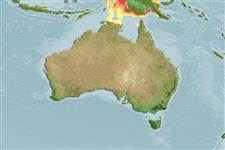Environment: milieu / climate zone / depth range / distribution range
Ecology
Marine; brackish; pelagic-neritic; depth range 0 - 50 m (Ref. 189). Tropical; 5°S - 13°S, 132°E - 148°E (Ref. 189)
Western Central Pacific: Papua New Guinea (Fly River) and northern Australia (near Darwin).
Size / Weight / Age
Maturity: Lm ? range ? - ? cm
Max length : 7.5 cm SL male/unsexed; (Ref. 189)
Dorsal spines (total): 0; Anal spines: 0; Anal soft rays: 32 - 29. Belly with 14 to 16 + 9 = 23 to 25 keeled scutes from isthmus to anus. Maxilla short, reaching to hind border of pre-operculum; first supra-maxilla short, about half length of second. Pseudobranch long. A diffuse dark saddle on nape; no dark blotch behind gill opening.
Presumed marine, pelagic and coastal, but at least the juveniles enter mangrove creeks of rivers, thus tolerating lowered salinities. More data needed.
Life cycle and mating behavior
Maturities | Reproduction | Spawnings | Egg(s) | Fecundities | Larvae
Wongratana, T., T.A. Munroe and M. Nizinski, 1999. Order Clupeiformes. Engraulidae. Anchovies. p. 1698-1753. In K.E. Carpenter and V.H. Niem (eds.) FAO species identification guide for fishery purposes. The living marine resources of the WCP. Vol. 3. Batoid fishes, chimaeras and bony fishes part 1 (Elopidae to Linophrynidae). FAO, Rome. (Ref. 9822)
IUCN Red List Status (Ref. 130435)
Threat to humans
Harmless
Human uses
Tools
Special reports
Download XML
Internet sources
Estimates based on models
Preferred temperature (Ref.
123201): 27.4 - 28.3, mean 27.9 °C (based on 84 cells).
Phylogenetic diversity index (Ref.
82804): PD
50 = 0.5000 [Uniqueness, from 0.5 = low to 2.0 = high].
Bayesian length-weight: a=0.00437 (0.00186 - 0.01024), b=3.11 (2.93 - 3.29), in cm total length, based on LWR estimates for this Genus-body shape (Ref.
93245).
Trophic level (Ref.
69278): 3.3 ±0.4 se; based on size and trophs of closest relatives
Resilience (Ref.
120179): High, minimum population doubling time less than 15 months (Preliminary K or Fecundity.).
Fishing Vulnerability (Ref.
59153): Low vulnerability (10 of 100).
